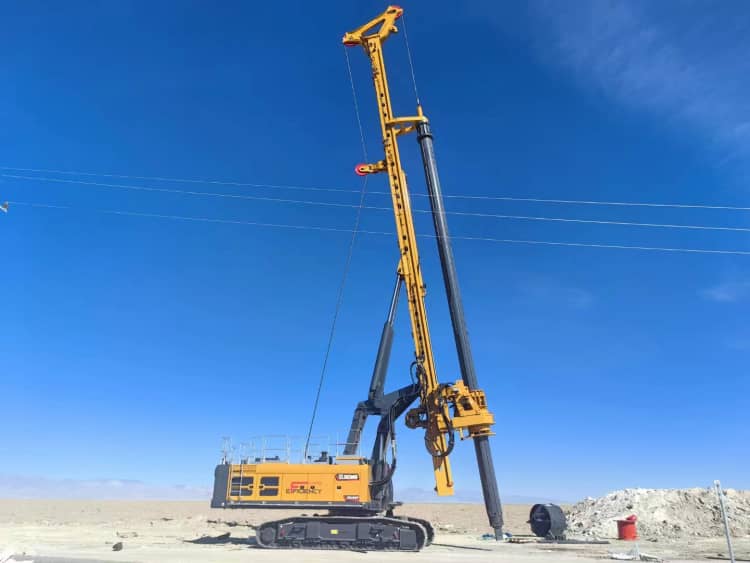Types of Prestressed Pipe Piles
Prestressed pipe piles are classified by concrete strength grade and wall thickness into:
- PHC piles (Prestressed High-strength Concrete piles): Minimum concrete strength grade C80
- PC piles (Prestressed Concrete piles): Concrete strength between C60 and C80
- PTC piles (Prestressed Thin-walled Concrete piles): Concrete strength between C60-C80
Standard pile diameters include: 300mm, 400mm, 500mm, 550mm, 600mm, 800mm, and 1000mm.
Piles are further categorized by bending performance or effective precompression stress values into:
- Type A: 4MPa
- Type AB: 6MPa
- Type B: 8MPa
- Type C: 10MPa
Application Scope
1. Hammer-Driven Piles
Best suited for:
- Clay soils
- Silty soils
- Situations requiring penetration through thick sandy soil interlayers or gravel-rich hard layers
Note: Noise pollution restricts urban use
2. Static Pressure Piles
Ideal for:
- Soft soils
- Fill soils
- General clay soils
- Urban areas with strict environmental requirements
- Sites near dense residential areas or dangerous buildings
Optimal bearing layers:
- Hard or stiff clay layers
- Medium-dense or dense gravel layers
- Sandy soils
- Completely weathered rock layers
- Strongly weathered layers
Not recommended for areas with:
- Underground boulders (>2m thick)
- Obstructions
- Medium-dense sand interlayers
Construction Processes
Hammer-Driven Pile Workflow
- Layout and positioning
- Pile driver positioning
- Prefabricated pile hoisting
- Pile stabilization
- Pile driving
- Pile splicing
- Pile feeding
- Hammer termination
Static Pressure Pile Workflow
- Layout and positioning
- Pile machine positioning
- Pile hoisting
- Pile pressing
- Pile splicing
- Pile feeding
- Termination conditions
Key Construction Techniques
Hammer-Driven Pile Method
- Positioning accuracy: Deviation <10mm
- Vertical alignment: Deviation ≤0.5%
- Driving principles: Heavy hammer with low impact
- Driving sequence: Deep→Shallow, Long→Short, Large→Small diameter
- Maximum strikes:
- PC piles: 2000 total, 250 final meter
- PHC piles: 2500 total, 300 final meters
- Waterproofing: Required for water-softening weathered rock layers
Static Pressure Method
- Continuous operation: Each pile should be pressed continuously
- Pressure sequence: Similar to hammer-driven sequence
- Termination criteria: Determined by field tests
- Quality checks: Monitor for abnormal sounds, machine issues, or pile damage
Quality Control Essentials
- Material Standards:
- PC piles: ≥C50 concrete
- PHC piles: ≥C80 concrete
- 100% design strength before driving
- Equipment Selection:
- Match equipment to geological conditions
- Avoid exceeding pile strength limits
- Site Preparation:
- Level ground with adequate bearing capacity
- Straightened guide rails
- Pile Handling:
- Proper storage and transportation
- Single-layer stacking preferred
- Careful hoisting to prevent damage
- Construction Monitoring:
- Double-check positioning
- Maintain vertical alignment
- Control daily pile quantity (≤12 in one area)
- Proper welding and cooling (≥8 minutes)
Common Quality Issues & Solutions
Frequent Problems:
- Insufficient single pile bearing capacity
- Excessive pile inclination
- Pile joint separation
- Significant position deviation
- Pile fractures
Root Causes:
- Inadequate depth
- Improper bearing layer
- Excessive final penetration
- Inaccurate survey data
- Poor pile quality
- Machine misalignment
- Construction sequence errors
Remedial Methods:
- Re-driving: For insufficient depth or uplifted piles
- Additional piles: Before or after cap construction
- Combination method: Redriving plus additional piles
- Cap enlargement: For position deviations or capacity issues
- Design modification: Adjust pile type or parameters
- Structural reinforcement: Load redistribution
Case Studies
Case 1: Wuhu Residential Building Incident
Issue: All test piles failed bearing capacity tests
Causes:
- Shortened pile length (18m→12m) without approval
- Removed cross steel pile tips
- Inadequate testing (only 4 test piles)
Solution: Converted to raft foundation with additional piles
Case 2: Changle Yingbin Road Project
Failures:
- Road surface defects (grooves, cracks, 30-50cm settlement)
- 0% qualified pile foundation
Root causes:
- Illegal bidding (142 of 149 companies colluded)
- Severe material reduction
- Absent supervision
- Financial mismanagement
Conclusion
Pile foundation quality requires comprehensive control:
- Strict construction management
- Enhanced site supervision
- Quality awareness training
- Standardized workflows
- Proactive quality measures


